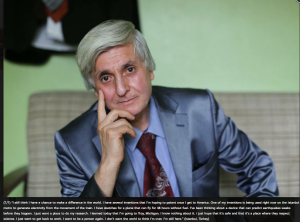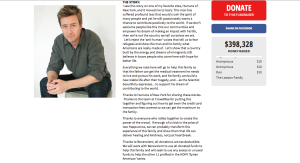Who was Obama talking to, and what possessed him to take a break from his presidential duties to respond in such a passionate, heartfelt way?
One of the reasons why is because Brandon Stanton, founder of Humans of New York, is at it again. Well, in reality, as a curator of stories, I think it’s fair to say Brandon is always at it, because he’s consistently providing us with a steady stream of beautiful stories. All you have to do is glance over at his website (or associated social media) to see that he’s always hard at work, connecting individual people to the rest of the world through the power of storytelling. These days, Stanton reaches far and wide. It’s not just about New York, anymore; he traverses boundaries on a global scale. In doing so, he illuminates current political problems through a lens of compassion, love, understanding, unity, and solidarity.
A recent narrative, centered around Syrian father and scientist immigrating to Troy, Michigan, particularly struck a chord with a lot of people. If you haven’t read it yet, spend some time on the HONY site to catch up on this series.
Can you explain why it resonated with you, and why President Obama and Edward Norton joined the chorus of thousands (if not millions) of voices?
Yes, Edward Norton. Norton was also deeply affected by this story, so much so that he was motivated to contact Stanton and ask if he could begin a fundraising campaign for the refugee and his children. So far, the total funds raised are just shy of $400,000!
There are a multitude of super important lessons illustrated by this HONY post and the subsequent press. I don’t think I have the time or the space to write about them all, so I’ll zero in on just a few.
1. Take advantage of opportunities to communicate, and communicate consistently. Stanton has taken advantage of all suitable channels of communication: Facebook, twitter, and the worldwide web — and connecting them all together. Figure out which channels on the internet and social media are best suited for your organization’s communication.
2. Cultivate an identity. At this point, we know very well who Stanton is and what he does, and what he wants to continue to do, and he’s rarely even in front of the camera. HONY has achieved what few organizations have by way of global appeal, but if you convey who you are and what you do, and tie your mission statement to all of the wonderful work your organization does, you’ll be in the best possible place.
3. Focus on both telling amazing stories, as well as curating them. It’s important to remember that Brandon is rarely the one speaking, and he’s never the one doing the actual storytelling. Instead, he is the one making choices on a constant basis, the choice of “Who?” He shines a bright light on those who have strong voices, and people open their ears — and eyes — to listen. That’s why I always refer to him as a story curator as opposed to a storyteller. Figure out which stories from your pool of narratives pack the hardest most emotional punch, and go with those.





















 I can’t wait to meet with you personally.
I can’t wait to meet with you personally.
Comments on this entry are closed.